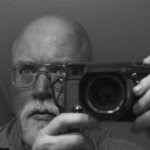
I admit to being overly partial to some people.
Andrés Segovia is one. He invented a genre of music, that of the classical guitar. This was classical (baroque might be more accurate) music played on a Spanish guitar. He did it first, he did it extremely well, and all others who follow are compared to him. He wasn’t perfect. John Williams might be a better technician.
Segovia’s hardened fingertips screeched on the strings, he slowed down and sped up in a way that was sometimes jazz-like, not baroque-like. It wasn’t perfect, but if he did it, it was right.
Henri Cartier-Bresson affects me the same way. It is difficult to find a photographer who will berate HCB’s printed legacy. He invented and mastered the genre of well-mannered street photography. He left us a large volume of work which, like Segovia’s work, is often imitated but not matched. And, like Segovia’s recorded legacy, it is hard to acquire all of the works nowadays without getting an enormous amount of duplication. Maybe duplication is the wrong word. It sounds like “two of”. Maybe multiplication is more like it. I have about 20 CDs of Andrés Segovia’s music. Among these CDs, I probably have Bach’s Chaconne 10 times. And I must have Granados’ Spanish Dance No. five 15 times. Collections of Henri Cartier-Bresson’s work are published, then out of print, then others are published, then out of print. If you buy 20 volumes of his photographs, you can expect to see some of the same photos 20 times.
It was with this sense of foreboding that I ordered “In Inner Silence: The Portraits of Henri Cartier-Bresson.” I have many copies of HCB’s portraits of Truman Capote, Samuel Beckett, Arthur Miller, and Jean-Paul Sartre. And now I have another copy of each as they are included in this collection. But my pleasant surprise was that there are many portraits here than I had not seen. And I can find something to like in all of them. They aren’t perfect; he didn’t shoot them in a studio, and he used a 35mm camera. The very first portrait, that of French painter Georges Rouault, is not perfect. The fabric of his coat is in sharper focus than are the reflections in his eyes. The fingers of his right hand are chopped off by the bottom edge of the frame. A cross and lamp shade are situated awkwardly behind and to the right of him. But these blemishes are not fatal to the portrait. The lighting is gentle, the reflections are soft, the tonality is rich, and the subject is not reacting to camera or photographer. Other portraits have even more prominent distractions. Henri Cartier-Bresson was not averse to allowing the sprocket holes of his 35mm film to appear on his prints. Some portraits are grainy and soft. Some have overexposed highlights. But despite these quibbles, the portraits work well and not simply because most of the subjects are renowned. They work because he framed his subjects well and pulled the trigger at the right time. And sometimes timing is everything. Some of the portraits are of average or even underprivileged people who didn’t know HCB but allowed him to shoot without returning a guarded expression. That was perhaps what made him the photographer he was. He could approach a subject, frame it, and know just when the pull the trigger while not alarming or annoying the person he was shooting. That’s something I aspire to but will never really master.
 I admit to being overly partial to some people. Andrés Segovia is one. He invented a genre of music, that of the classical guitar. This was classical (baroque might be more accurate) music played on a Spanish guitar. He did it first, he did it extremely well, and all others who follow are compared to him. He wasn’t perfect. John Williams might be a better technician.
I admit to being overly partial to some people. Andrés Segovia is one. He invented a genre of music, that of the classical guitar. This was classical (baroque might be more accurate) music played on a Spanish guitar. He did it first, he did it extremely well, and all others who follow are compared to him. He wasn’t perfect. John Williams might be a better technician. 

<< Home